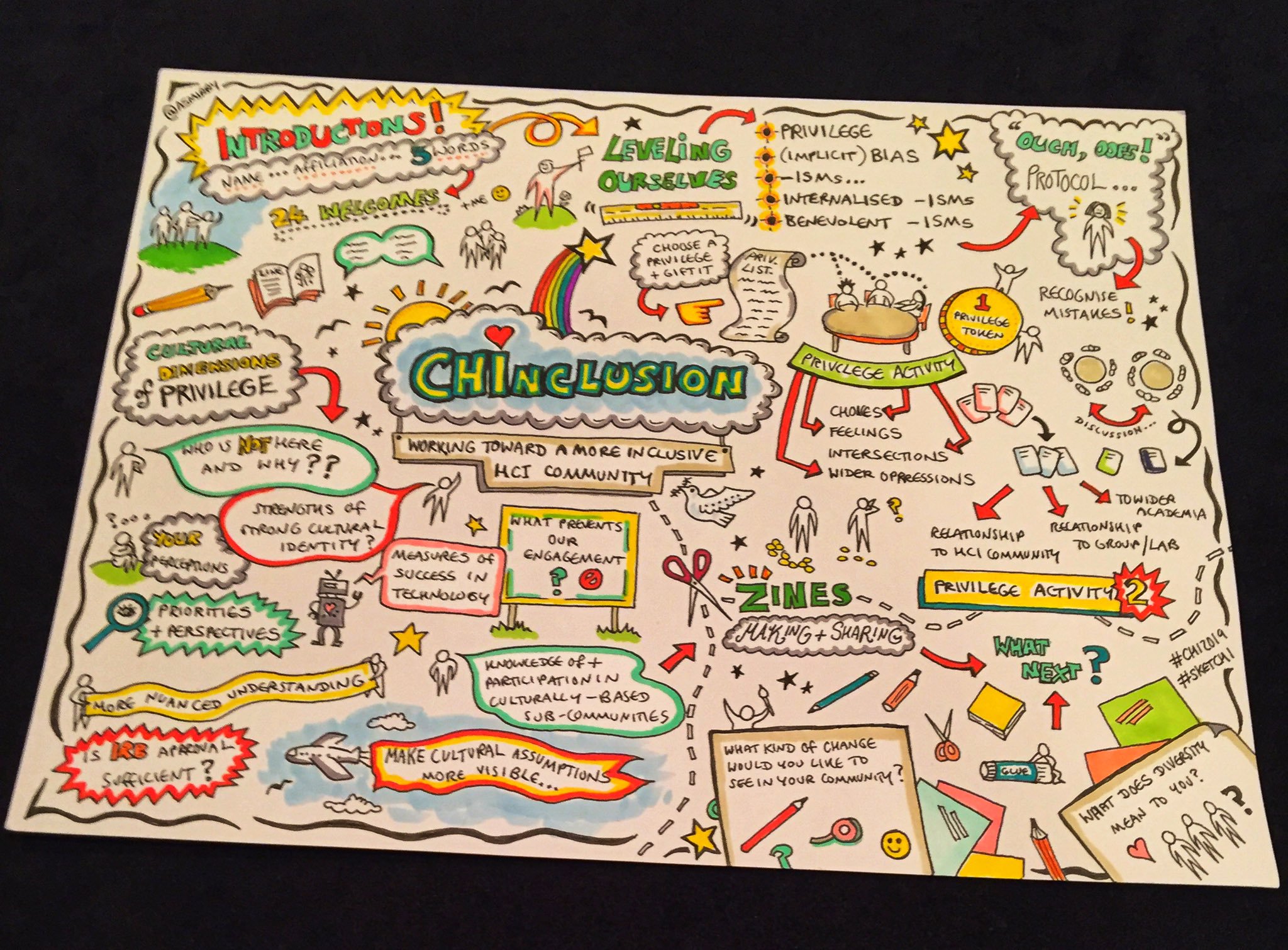
Sketchnote documenting the day in our workshop, by the amazing and talented Dr. Miriam Sturdee (Source)
“CHInclusion: Working Toward a More Inclusive HCI Community”
is a full-day workshop accepted and run at CHI 2019 in Glasgow, Scotland with: Angelika Strohmayer (Newcastle University), Velvet Spors (University of Nottingham), Michael Muller (IBM Research), Morgan Vigil-Hayes (Northern Arizona University), and Ebtisam Alabdulqader (King Saud University & Newcastle University).Abstract: HCI has a growing body of work regarding important social and community issues, as well as various grassroots communities working to make CHI more international and inclusive. In this workshop, we will build on this work: first reflecting on the contemporary CHI climate, and then developing an actionable plan towards making CHI2019 and subsequent SIGCHI events and sister conferences more inclusive for all.
Publication: Available on the ACM Digital Library (doi>10.1145/3290607.3299012)
 Diagram of intersecting axes of privilege, domination, and oppression, which was used to spark discussion and reflection in the workshop. We also brainstormed axes that are not represented here but remain relevant in such dynamics, such as having a criminal record, coming from a stable family environment, and so on. (Source)
Diagram of intersecting axes of privilege, domination, and oppression, which was used to spark discussion and reflection in the workshop. We also brainstormed axes that are not represented here but remain relevant in such dynamics, such as having a criminal record, coming from a stable family environment, and so on. (Source)“Gaming with the Subaltern: Workshop on Diversity and Inclusion in Games”
is a full-day workshop accepted and run at CHIPLAY 2018 in Melbourne, Australia with: Cale J. Passmore (University of Saskatchewan), Regan L. Mandryk (University of Saskatchewan), Sarah Schoemann (Georgia Institute of Technology), Daniel Gardner (University of California, Irvine), Mark Hancock (University of Waterloo), Mahli-Ann Butt (University of Sydney), and Josh Tanenbaum (University of California, Irvine).Background: Players, developers, and researchers have long recognized the absence of diversity in digital gaming, development, and research. This lack of diversity (in e.g., game characters, worlds, narratives), reflected in the lack of diversity within developer culture, has been tied to decreased player enjoyment, lasting negative affect, lower cognitive benefits, less agency, and increased prejudice. Though there are myriad benefits of gaming—demonstrating why gaming is so popular—the current lack of diversity makes access to these benefits unequal based on unchanging attributes of self (e.g., gender, ethnicity, ability, age).
Players and developers are aware of the negative effects tied to over-representation of gaming’s most prolific protagonist type (i.e., the hypermasculine white male with brown hair saving the day), and calls for corrective action are plentiful. However, attempts at inclusion are often diffused through stereotypical and tokenistic inclusion of people, lacking recognition of complex social power structures around gaming with the subaltern: i.e., populations socially, politically, and geographically outside of the hegemonic power structure of the colonial homeland.
Research focused on individual identity axes (e.g., gender, race, neuroatypicality; see diagram above) is gaining momentum in human-computer interaction (HCI); however, these approaches are limited by their singular approach to identity. Although diversity and inclusion are values endorsed by most players and developers, games diverse across several axes remain scarce. The mere variability of human experiences poses hard problems to development teams comprised of 70%+ white men: how can teams overcome biases to accurately represent cultures, peoples other than their own? Further, scientific methodologies prescribe methods for removing “outliers” to increase homogeneity of datasets—a practice that does not translate when the outlier is a marginalized minority. Relatedly, data-driven decision making is, by definition, exclusionary, as focus on majority opinion marginalizes underrepresented groups, as recently evidenced in the twitter response to the CHI 2018 opening keynote.
How do individual differences affect results, methods, and gameplay experiences? What perspectives and experiences are shared by people across power axes? Which are unique? What do all game researchers and developers need to understand regarding identity dynamics when gathering data, interpreting results, or presenting information? What does intersectionality (i.e., considering multiple power axes in combination) look like in gaming, game development and research? Our workshop is built around these key questions in the hope that shared insights will allow us to move from simply valuing diversity toward successful intersectional practices in research, development, and play.
Our goals include gathering the community of diversity researchers, sharing our knowledge and practices with one another, and collectively understanding the intersections of race, gender, sexuality, ability, neuroatypicality, and cross-cultural issues in games research. Our shared knowledge will begin with the mutual building of known biases, successes, and sites of ongoing oppression. This will form a snapshot of our current strengths, weaknesses, opportunities, and threats to real diversity in games and games user research (GUR). We will map common identity factors to key research areas, revealing shared and unshared dynamics. This map will advance our collective practices and identify current, recurring barriers to diversity, and inform a later document on considerations for researchers and developers when working with diverse populations. The results of our workshop will be published to an online, publicly available website for comment, critique, and information. This living document will help inform future games research and development.
Publication: Available on the ACM Digital Library (doi>10.1145/3270316.3271552)
Workshop website: subalterngur.wordpress.com